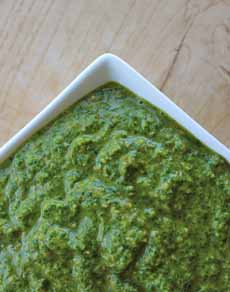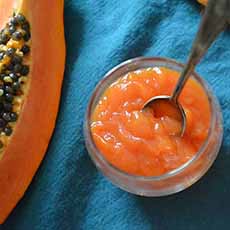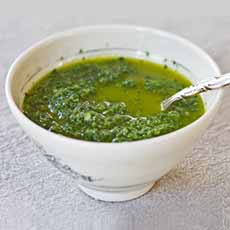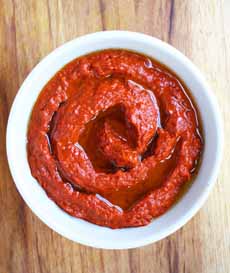TIP OF THE DAY: International Sauces On Everyday Favorites ~ Part 1 Of 3
|
|
Many of us eat global cuisine at restaurants, but why not dabble in them more often at home? A simple path is to add an international-style sauce to chicken, fish and other everyday foods. Flavor & The Menu, a resource for restaurant chefs nationwide, offers 12 global sauces for you to try. They range from mild to spicy—and of course, you control the level of heat in your own kitchen. We’re presenting these dozen dazzlers in a three-part article, so you can “digest” your thoughts—four sauces at a time. Some are thin like marinade, others are pastes that can be thinned with broth, oil or water. This bright herb sauce and marinade from North Africa has cumin as its main ingredient. It is typically ground or blended into a paste with garlic, cilantro or other herbs, olive oil, salt and pepper. While chermoula is often used as a sauce accompaniment to seafood in countries like Algeria, Libya, Morocco and Tunisia, it can also shine in “American” cuisine: Fruit adds sweetness and texture to a sauce, helping to round out richer dishes and tame those with a bit of spice. American and European recipes have long used berries, citrus and stone fruits to sauce both savory and sweet dishes. Go global and make sauces from more tropical fruits—cherimoya, guava, mango, pineapple. Season them with spices from another culture—chile, curry, ginger, lemongrass, star anise…the combinations are endless. The name is new to us, but the concept is familiar: It’s a type of Indian curry (a.k.a. gravy). Makhani is traditionally made by simmering green and red chiles, tomatoes, ginger, garlic, spices, nuts and seeds in plenty of butter, and then grounding or blending it into a paste. Thanks to a growing interest in Indian cuisine, bright red makhani sauce can move beyond Chicken Butter Masala, Paneer Butter Masala, and egg and vegetarian Indian dishes, to flavorful fusion dishes. Consider the sauce on: As with most hot sauces used in the U.S., Middle Eastern hot sauces work across cuisines, providing lots of fusion opportunity. Harissa is perhaps the best known, but take a look at s’chug, with bright, acidic notes from cilantro and green chiles. Another hot sauce to watch is shatta, from Lebanon. It blends Kashmiri red chiles, lemon juice, garlic and chile powder. Perfect with Middle Eastern dishes like shawarma, these sauces work equally well with tacos, wings and more. In fact, how about a plate of tacos or wings with all three hot sauces for a fact-finding mission (i.e., which Middle Eastern hot sauce you like best)? |
|
|
|
||







